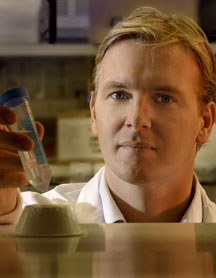

A Ghost in the House
By Eric Sauter
After finishing his bachelor's degree at Trinity College Dublin, Paul Kenny spent a year at St. Patrick's Hospital, the first psychiatric hospital in Ireland, to sort out whether he wanted to pursue a medical career. He picked an auspicious place to make up his mind. St. Patrick's was the result of a bequest by Jonathan Swift, author of Gulliver's Travels, who, when he died in 1745, left his entire estate to found the institution.
Like many who find their lives in science, Kenny found his early. The 35-year-old lab head, who was recently promoted to associate professor in the Department of Molecular Therapeutics at Scripps Florida, was drawn to the sight of human brain cells on a slide while still in high school.
"No one else in my family is involved in science at all," he said. "But I loved it from the very beginning—the excitement of it, the possibility of discovering something no one else had found. At Trinity, I worked on brain-related studies, but it was fairly basic stuff; there weren't many big neurobiology labs in Dublin working in areas that I was interested in. I knew I wanted to do behaviorally oriented work, so I spent a year in our main psychiatric hospital working with patients."
At St. Patrick's, Kenny quickly discovered he wasn't suited to clinical work and that his natural inclination was toward basic research. Basic research carried its own attraction—if properly applied, it offered the potential to help many people. The experience provided enough real-life insight to help turn him into one of the young leaders in the fast-growing field of addiction science.
"I saw first-hand the damage addiction does to people," he said. "Of course, I was young and perhaps a bit naïve, but it was shocking then, and it's still shocking now, how terrible these addictions really are. I had no idea of the suffering."
Kenny decided then and there that he wanted to work in the field of addiction.
A Powerful Substance
After St. Patrick's, Kenny spent several years at King's College in London, where he became interested in nicotinic receptors and nicotine itself, now recognized as one of the most powerfully addictive substances on the planet.
"From my own research experience and from animal model data," Kenny said, "nicotine induces plasticity, changes in the brain, at the lowest levels of exposure and the lowest concentration of almost any addictive drug. Even very brief exposure to the small amounts of nicotine in a single cigarette can profoundly alter how the brain functions. Cocaine, for example, also produces changes, but the process appears to take slightly longer and requires more of the drug."
These changes in the brain alter reward pathways so that the system basically turns in on itself, twisting this way and that to adapt to a new reality of addiction.
Kenny notes that many scientists look at addiction and addictive substances as an accident of evolution. "Reward pathways developed so we could respond to food, water, sex," he said. "Addictive drugs are chemicals that can artificially activate those reward pathways. They corrupt this circuitry."
If you repeatedly take a drug, what you are left with is the brain's adaptation to it. These adaptations may underlie addiction.
This problem is acute with nicotine. In a 2006 study published in the journal Neuropsychopharmacology, Kenny and colleagues made the point that nicotine is in a category by itself when it comes to addiction. The study showed that nicotine increases the sensitivity of the brain's reward systems, and that the stimulatory action of nicotine is long lasting, in rats lingering at least 36 days after nicotine intake had ceased.
Kenny and his colleagues are now exploring the intriguing question of how they might be able to reverse these effects of nicotine addiction. The team is currently focusing on the involvement of many known neurotransmitter systems in the brain and also working on relatively unexplored systems that may play a role in brain plasticity and drug addiction.
The Lure of Results
These are the kinds of high-impact studies that attracted Kenny and his wife (Dympna Harmey, a staff scientist in Scripps Florida's Translational Research Institute) to Scripps Research in the first place. Formerly a research associate in the Department of Neuropharmacology on the California campus of Scripps Research, Kenny is delighted with the opportunity to launch his own research group.
"Starting a lab has been challenging and rewarding, trying to recruit the best people—I've been very lucky in that area—and to work on the best projects," he said. " We can take our data in new directions. For example, one of the grants we received will help us develop a new addiction treatment, a small molecule that may be of benefit for drug dependence. We're also testing whether obesity may be considered an addiction to high-fat, high-sugar food. Where else would you have the opportunity to do all that?"
This breadth of Kenny's scientific interest in addiction circles back on something he learned first-hand at St. Patrick's Hospital: drug habits of any sort can differ dramatically between people in different circumstances, but they almost always cause enormous damage. In a paper on compulsive drug use, Kenny quoted Jean Cocteau, the French avant-garde artist, describing his withdrawal from opium: "The dead drug leaves a ghost behind. At certain hours it haunts the house."
Which is another way of explaining Paul Kenny's drive to find answers to the questions raised by the specter of addiction.
Send comments to: mikaono[at]scripps.edu

Neurobiologist Paul Kenny works to understand the mysteries of addiction. Photo by Randy Smith.
